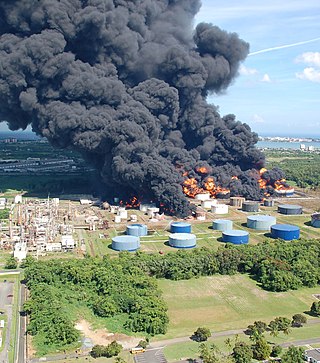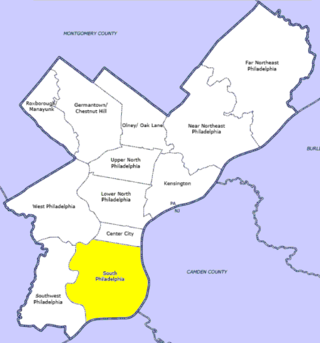Related Research Articles

A gas explosion is the ignition of a mixture of air and flammable gas, typically from a gas leak. In household accidents, the principal explosive gases are those used for heating or cooking purposes such as natural gas, methane, propane, butane. In industrial explosions, many other gases, like hydrogen, as well as evaporated (gaseous) gasoline or ethanol play an important role. Industrial gas explosions can be prevented with the use of intrinsic safety barriers to prevent ignition, or use of alternative energy.

On May 4, 1988, a fire followed by several explosions occurred at the Pacific Engineering and Production Company of Nevada (PEPCON) chemical plant in Henderson, Nevada. The disaster caused two fatalities, 372 injuries, and an estimated $100 million of damage. A large portion of the Las Vegas Valley within a 10-mile (16 km) radius of the plant was affected and several agencies activated disaster plans.

The Buncefield fire was a major fire at an oil storage facility that started at 06:01 UTC on Sunday 11 December 2005 at the Hertfordshire Oil Storage Terminal, located near the M1 motorway, Hemel Hempstead, in Hertfordshire, England. The terminal was the fifth largest oil-products storage depot in the United Kingdom, with a capacity of about 60 million imperial gallons (270,000 m3) of fuel. The terminal is owned by Total UK Limited (60%) and Texaco (40%).

Coode Island is a former island at the convergence of the Yarra and Maribyrnong Rivers, 4 km west of central Melbourne, Australia. The island was formed by the excavation of the Coode Canal in 1887, and became connected to the mainland in the 1930s. Today the low-lying land is part of the Port of Melbourne, and is used as the site of Swanson and Appleton Docks and their associated container storage and rail yards, as well as a number of chemical storage facilities.
The Hub Oil explosion was an industrial accident that occurred on August 9, 1999, in Calgary, Alberta, resulting in two fatalities. The Hub Oil refinery was situated at 5805 17 Avenue SE, near the eastern edge of Calgary and just south of the residential community of Penbrooke.

The Toronto propane explosion was a series of explosions and ensuing fire that took place on the morning of August 10, 2008, in the Downsview neighbourhood of North York, Toronto, Ontario, Canada. The explosions occurred at the Sunrise Propane Industrial Gases propane facility, located near Keele Street and Wilson Avenue around 03:50 ET. The blasts caused thousands of people to be evacuated from their homes and cost C$1.8 million to clean up, half of which was paid by the province of Ontario. An employee of Sunrise died in the initial explosions and a firefighter died of cardiac arrest the next day while at the scene.

The Pembroke Refinery is an oil refinery situated on the Pembrokeshire coast in Wales at Rhoscrowther in the community of Angle. It first came on stream in 1964 and was Regent/Texaco's only British refinery. The refinery occupies a prominent position on the south bank of the Milford Haven Waterway and can be seen for many miles. Around a quarter of the site is within the Pembrokeshire Coast National Park which was created in 1952.
A boilover is an extremely hazardous phenomenon in which a layer of water under a pool fire starts boiling, which results in a significant increase in fire intensity accompanied by violent expulsion of burning fluid to the surrounding areas. Boilover can only occur if the liquid fluid is a mixture of different chemical species with sufficiently diverse boiling points, although a so-called thin-layerboilover – a far less hazardous phenomenon – can arise from any water-immiscible liquid fuel. Crude oil, kerosene and some diesel oils are examples of fuels giving rise to boilover.

The Paraguaná Refinery Complex is a crude oil refinery complex in Venezuela. It is considered the world's second largest refinery complex, just after Jamnagar Refinery (India). The Paraguaná Refinery Complex was created by the fusion of Amuay Refinery, Bajo Grande Refinery and Cardón Refinery. The Paraguana Refinery Complex is still the largest refinery in the Western Hemisphere. As of 2012, it refined 955 thousand barrels per day (151,800 m3/d). The complex is located in the Paraguaná Peninsula in Falcón state and the western coast of Lake Maracaibo in the Zulia state. The complex accounts for 71% of the refining capacity of Venezuela and it belongs to the state-owned company Petróleos de Venezuela (PDVSA).

The 2009 Cataño oil refinery fire, also known as the CAPECO explosion, was a fire that began with an explosion on October 23, 2009, and was extinguished on October 25 at the Caribbean Petroleum Corporation (CAPECO) oil refinery and oil depot in Bayamón, Puerto Rico. While the fire and subsequent explosion occurred close to the city of Cataño, it technically occurred within the borders of Bayamón, even though Cataño was more affected by fumes and evacuation. There were no fatalities, but 3 people were injured.

A refinery owned by Gulf Oil Corporation in Philadelphia, located at Girard Point on the Schuylkill River in South Philadelphia, caught fire on Sunday, August 17, 1975. This incident grew into an 11-alarm fire, not brought under control until 24 hours later, and resulted in the death of eight firefighters of the Philadelphia Fire Department (PFD), injuries to 14 other firefighters, and the loss of four PFD vehicles.
The Marathon Martinez Renewable Fuels Facility is located in the San Francisco Bay Area in an unincorporated area known as Avon, East of Martinez, California. It refines biobased feedstocks such as animal fat, soybean oil and corn oil into renewable diesel. Previously owned by Tidewater Petroleum, Tosco, Valero Energy, Tesoro and Marathon Petroleum. The refinery is located on 850 acres, in 2016 had approximately 650 full-time employees, and had a crude oil capacity of 157,000 barrels per day. In 2015 it was the fourth-largest refinery in the state. The refinery had a Nelson complexity index of 16.1.

Milford Haven Refinery was an oil refinery situated on the Pembrokeshire coast in Wales, United Kingdom. The refinery began operating in 1973 under Amoco's ownership, but in its final years it was owned by Murco Petroleum. The closure of the refinery was announced in November 2014. The site was sold to Puma Energy in 2015 for use as a petroleum storage and distribution terminal.
An explosion at the ARCO Chemical (ACC) Channelview, Texas petrochemical plant killed 17 people and injured five others on July 5, 1990. It was one of the deadliest industrial disasters in the history of the Greater Houston area.
A series of unusual fires and explosions have occurred in Russia since the invasion of Ukraine in February 2022, which have not been formally explained. There have been many notable arson attacks on military recruitment offices in Russia since the beginning of the war, and there has been speculation that some of the fires or explosions have been the result of sabotage efforts by Russian partisans or Ukrainian saboteurs.
This article covers events in the year 2022 in Cuba.
The Tacoa disaster occurred on December 19, 1982 as a result of a fuel oil tank fire on the premises of the Ricardo Zuloaga thermal power plant, owned by Electricidad de Caracas and located in Tacoa, a seaside village and an area of Vargas, Venezuela.
References
- ↑ "Explosions rock Cuba as fire at oil facility kills 1, injures 125". Washington Post. ISSN 0190-8286 . Retrieved 16 August 2022.
- ↑ "17 missing, dozens hurt as fire rages in Cuban oil tank farm". www.cbsnews.com. Archived from the original on 9 August 2022. Retrieved 10 August 2022.
- ↑ "A raging fire at a Cuban oil facility worsens the island's energy crisis". NPR. Associated Press. 9 August 2022. Archived from the original on 12 August 2022. Retrieved 10 August 2022.
- ↑ Havana, AP in (9 August 2022). "Fire spreads at Cuba oil storage facility as fourth tank erupts". the Guardian. Archived from the original on 10 August 2022. Retrieved 10 August 2022.
- ↑ "Third fuel tank collapses as fire rages at Cuba oil terminal". www.aljazeera.com. Archived from the original on 10 August 2022. Retrieved 10 August 2022.
- ↑ "Cuba's worst ever fire brought under control after 5 days, officials say". CNN. Reuters. Archived from the original on 12 August 2022. Retrieved 10 August 2022.
- ↑ "U.S. faces mounting pressure to do more to help Cuba fight a deadly blaze at an oil facility". NBC News. Archived from the original on 9 August 2022. Retrieved 10 August 2022.